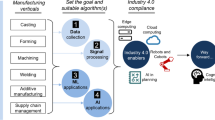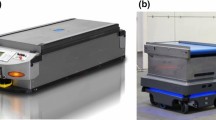Abstract
Current manufacturing systems have a tendency to become more and more flexible to adapt to the needs of product diversification. Such a system, e.g. flexible manufacturing system, consists of a number of automatic machines, material handling devices such as automated guided vehicles (AGVs) or mobile robots, and a central control computer. Mobile robots, as well as AGVs, can move around in their working space to transport components among machines. The main novelty of this work is that mobile robots can also execute various value-added tasks without human intervention thanks to their manipulation arms which is not possible for AGVs. This new characteristic certainly makes the problem more complex and computationally expensive. To utilize these manufacturing systems in an efficient manner, it is necessary to schedule transportation of product components by mobile robots and to schedule processing of products on machines possibly by mobile robots. Consequently, the key innovation of this work lies in consideration of three interrelated sub-problems which must be solved. They include computing the sequence of operations on machines, the robot assignment for transportation, and the robot assignment for processing. To achieve this goal, a computationally efficient hybrid heuristic method combining genetic algorithm and tabu search is developed to solve the problem considering makespan minimization. A mixed-integer programming (MIP) model is formulated. Another combined method using results of the hybrid heuristic is proposed to speed up the solving of MIP model. The quality of hybrid heuristic’s solutions is compared and evaluated by using those of the MIP model as reference points.







Similar content being viewed by others
Notes
We have also attempted to feed full solutions from the heuristic into CPLEX, the results are however quite close. This is because the branch-and-cut algorithm of CPLEX spends a large amount of time on the binary decisions variables, i.e. xijk, hijk, αijk, ωijk. Hence, feeding of full solutions is not considered in our paper.
Instances are also available from https://sites.google.com/site/schedulingmobilerobots.
“Appendices A and B” are also available from https://sites.google.com/site/schedulingmobilerobots.
Detailed results for further comparisons between the hybrid heuristic and the other proposed approaches for the two groups of problems are presented in Tables 12.1 and 13.1, which are available from https://sites.google.com/site/schedulingmobilerobots.
References
Abdelmaguid, T.F., Nassef, A.O., Kamal, B.A., Hassan, M.F.: A hybrid GA/heuristics approach to the simultaneous scheduling of machines and automated guided vehicles. Int. J. Prod. Res. 42(2), 267–281 (2004)
Antony, J.: Design of Experiments for Engineers and Scientists. Elsevier, Amsterdam (2014)
Arabas, J., Michalewicz, Z., Mulawka, J.: GAVaPS-a genetic algorithm with varying population size. In: Arabas, J., et al. (eds.) Evolutionary Computation, IEEE World Congress on Computational Intelligence, pp. 73–78. IEEE (1994)
Bilge, U., Ulusoy, G.: A time window approach to simultaneous scheduling of machines and material handling system in an FMS. Oper. Res. 43(6), 1058–1070 (1995)
Błażewicz, J., Domschke, W., Pesch, E.: The job shop scheduling problem: conventional and new solution techniques. Eur. J. Oper. Res. 93(1), 1–33 (1996)
Chaudhry, I.A., Mahmood, S., Shami, M.: Simultaneous scheduling of machines and automated guided vehicles in flexible manufacturing systems using genetic algorithms. J. Cent. South Univ. Technol. 18(5), 1473–1486 (2011)
Dang, Q.V., Nguyen, L.: A heuristics approach to schedule mobile robots in flexible manufacturing environments. Procedia CIRP 40, 390–395 (2016)
Gen, M., Cheng, R., Lin, L.: Network Models and Optimization. Springer, London (2008)
Gnanavel Babu, A., Jerald, J., Noorul Haq, A., Muthu Luxmi, V., Vigneswaralu, T.P.: Scheduling of machines and automated guided vehicles in FMS using differential evolution. Int. J. Prod. Res. 48(16), 4683–4699 (2010)
Goldberg, D.E.: Genetic Algorithms in Search, Optimization, and Machine Learning. Addison-Wesley, Boston (1989)
Gormley, M.R., Eisner, J.: Nonconvex global optimization for latent-variable models. In: Proceedings of the 51st Annual Meeting of the Association for Computational Linguistics, pp. 444–454 (2013)
Hvilshøj, M., Bøgh, S., Nielsen, O.S., Madsen, O.: Autonomous industrial mobile manipulation (AIMM): past, present and future. Ind. Robot Int. J. 39(2), 120–135 (2012)
Jerald, J., Asokan, P., Saravanan, R., Delphin Carolina Rani, A.: Simultaneous scheduling of parts and automated guided vehicles in an FMS environment using adaptive genetic algorithm. Int. J. Adv. Manuf. Technol. 29(5), 584–589 (2006)
Koumousis, V.K., Katsaras, C.P.: A saw-tooth genetic algorithm combining the effects of variable population size and reinitialization to enhance performance. IEEE Trans. Evol. Comput. 10(1), 19–28 (2006)
Kumar, M.V.S., Rao, C.S.P., Rangajanardhan, G.: A hybrid differential evolution approach for simultaneous scheduling problems in a flexible manufacturing environment. Int. J. Appl. Manag. Technol. 6(3), 108–130 (2008)
Lacomme, P., Larabi, M., Tchernev, N.: Job-shop based framework for simultaneous scheduling of machines and automated guided vehicles. Int. J. Prod. Econ. 143(1), 24–34 (2013)
Lin, J.T., Chiu, C.C., Chang, Y.H., Chen, H.M.: A hybrid genetic algorithm for simultaneous scheduling of machines and AGVs in FMS. In: Gen, M., et al. (eds.) Industrial Engineering, Management Science and Applications, pp. 277–286. Springer, Berlin (2015)
Lu, Y.: Industry 4.0: a survey on technologies, applications and open research issues. J. of Ind. Inf. Integr. 6, 1–10 (2017)
MacDougall, W.: Industrie 4.0 smart manufacturing for the future. Germany Trade and Invest. http://www.gtai.de/GTAI/Content/EN/Invest/_SharedDocs/Downloads/GTAI/Brochures/Industries/industrie4.0-smart-manufacturing-for-the-future-en.pdf (2014). Accessed 22 Feb 2018
Mousavi, M., Yap, H.J., Musa, S.N., Dawal, S.Z.M.: A fuzzy hybrid GA-PSO algorithm for multi-objective AGV scheduling in FMS. Int. J. Simul. Model. 16(1), 58–71 (2017)
Nguyen, L., Dang, Q.V., Nielsen, I.: GA-Based scheduling for transporting and manufacturing mobile robots in FMS. In: Omatu, S., et al. (eds.) Distributed Computing and Artificial Intelligence, 13th International Conference, AISC 474, pp. 555–563. Springer, Switzerland (2016)
Nielsen, I., Dang, Q.V., Nielsen, P., Pawlewski, P.: Scheduling of mobile robots with preemptive tasks. In: Omatu, S., et al. (eds.) Distributed Computing and Artificial Intelligence, 11th International Conference, AISC 290, pp. 19–27. Springer, Switzerland (2014)
Pinedo, M.L.: Scheduling: Theory, Algorithms, and Systems. Springer, New York (2012)
Reddy, B.S.P., Rao, C.S.P.: A hybrid multi-objective GA for simultaneous scheduling of machines and AGVs in FMS. Int. J. Adv. Manuf. Technol. 31(5), 602–613 (2006)
Shivanand, H.K., Benal, M.M., Koti, V.: Flexible Manufacturing System. New Age International, New Delhi (2006)
Thoben, K.D., Wiesner, S., Wuest, T.: “Industrie 4.0” and smart manufacturing—a review of research issues and application examples. Int. J. Autom. Technol. 11(1), 4–16 (2017)
Udhayakumar, P., Kumanan, S.: Task scheduling of AGV in FMS using non-traditional optimization techniques. Int. J. Simul. Model. 9(1), 28–39 (2010)
Ulusoy, G., Sivrikaya-Şerifoǧlu, F., Bilge, Ü.: A genetic algorithm approach to the simultaneous scheduling of machines and automated guided vehicles. Comput. Oper. Res. 24(4), 335–351 (1997)
Umar, U.A., Ariffin, M.K.A., Ismail, N., Tang, S.H.: Hybrid multiobjective genetic algorithms for integrated dynamic scheduling and routing of jobs and automated-guided vehicle (AGV) in flexible manufacturing systems (FMS) environment. Int. J. Adv. Manuf. Technol. 81(9–12), 2123–2141 (2015)
Zheng, Y., Xiao, Y., Seo, Y.: A tabu search algorithm for simultaneous machine/AGV scheduling problem. Int. J. Prod. Res. 52(19), 5748–5763 (2014)
Author information
Authors and Affiliations
Corresponding author
Appendices
Appendix A
1.1 Data for traveling times used in test problems
Appendix B
2.1 Data for the job sets used in test problems
The operations marked by underlines are assumed to need a robot for processing
-
Job Set 1
-
Job 1: M1(8); M2(16); M4(12)
-
Job 2: M1(20); M3(10); M2(18)
-
Job 3: M3(12); M4(8); M1(15)
-
Job 4: M4(14); M2(18)
-
Job 5: M3(10); M1(15)
-
Job Set 2
-
Job 1: M1(10); M4(18)
-
Job 2: M2(10); M4(18)
-
Job 3: M1(10); M3(20)
-
Job 4: M2(10); M3(15); M4(12)
-
Job 5: M1(10); M2(15); M4(12)
-
Job 6: M1(10); M2(15); M3(12)
-
Job Set 3
-
Job 1: M1(16); M3(15)
-
Job 2: M2(18); M4(15)
-
Job 3: M1(20); M2(10)
-
Job 4: M3(15); M4(10)
-
Job 5: M1(8); M2(10); M3(15); M4(17)
-
Job 6: M2(10); M3(15); M4(8); M1(15)
-
Job Set 4
-
Job 1: M4(11); M1(10); M2(7)
-
Job 2: M3(12); M2(10); M4(8)
-
Job 3: M2(7); M3(10); M1(9); M3(8)
-
Job 4: M2(7); M4(8); M1(12); M2(6)
-
Job 5: M1(9); M2(7); M4(8); M2(10); M3(8)
-
Job Set 5
-
Job 1: M1(6); M2(12); M4(9)
-
Job 2: M1(18); M3(6); M2(15)
-
Job 3: M3(9); M4(3); M1(12)
-
Job 4: M4(6); M2(15)
-
Job 5: M3(3); M1(9)
-
Job Set 6
-
Job 1: M1(9); M2(11); M4(7)
-
Job 2: M1(19); M2(20); M4(13)
-
Job 3: M2(14); M3(20); M4(9)
-
Job 4: M2(14); M3(20); M4(9)
-
Job 5: M1(11); M3(16); M4(8)
-
Job 6: M1(10); M3(12); M4(10)
-
Job Set 7
-
Job 1: M1(6); M4(6)
-
Job 2: M2(11); M4(9)
-
Job 3: M2(9); M4(7)
-
Job 4: M3(16); M4(7)
-
Job 5: M1(9); M3(18)
-
Job 6: M2(13); M3(19); M4(6)
-
Job 7: M1(10); M2(9); M3(13)
-
Job 8: M1(11); M2(9); M4(8)
-
Job Set 8
-
Job 1: M2(12); M3(21); M4(11)
-
Job 2: M2(12); M3(21); M4(11)
-
Job 3: M2(12); M3(21); M4(11)
-
Job 4: M2(12); M3(21); M4(11)
-
Job 5: M1(10); M2(14), M3(18); M4(9)
-
Job 6: M1(10); M2(14), M3(18); M4(9)
-
Job Set 9
-
Job 1: M3(9); M1(12); M2(9); M4(6)
-
Job 2: M3(16); M2(11); M4(9)
-
Job 3: M1(21); M2(18); M4(7)
-
Job 4: M2(20); M3(22); M4(11)
-
Job 5: M3(14); M1(16); M3(13); M4(9)
-
Job Set 10
-
Job 1: M1(11); M3(19); M2(16); M4(13)
-
Job 2: M2(21); M3(16); M4(14)
-
Job 3: M3(8); M2(10); M1(14); M4(9)
-
Job 4: M2(13); M3(20); M4(10)
-
Job 5: M1(9); M3(16); M4(18)
-
Job 6: M2(19); M1(21), M3(11); M4(15)
Rights and permissions
About this article
Cite this article
Dang, QV., Nguyen, C.T. & Rudová, H. Scheduling of mobile robots for transportation and manufacturing tasks. J Heuristics 25, 175–213 (2019). https://doi.org/10.1007/s10732-018-9391-z
Received:
Revised:
Accepted:
Published:
Issue Date:
DOI: https://doi.org/10.1007/s10732-018-9391-z




